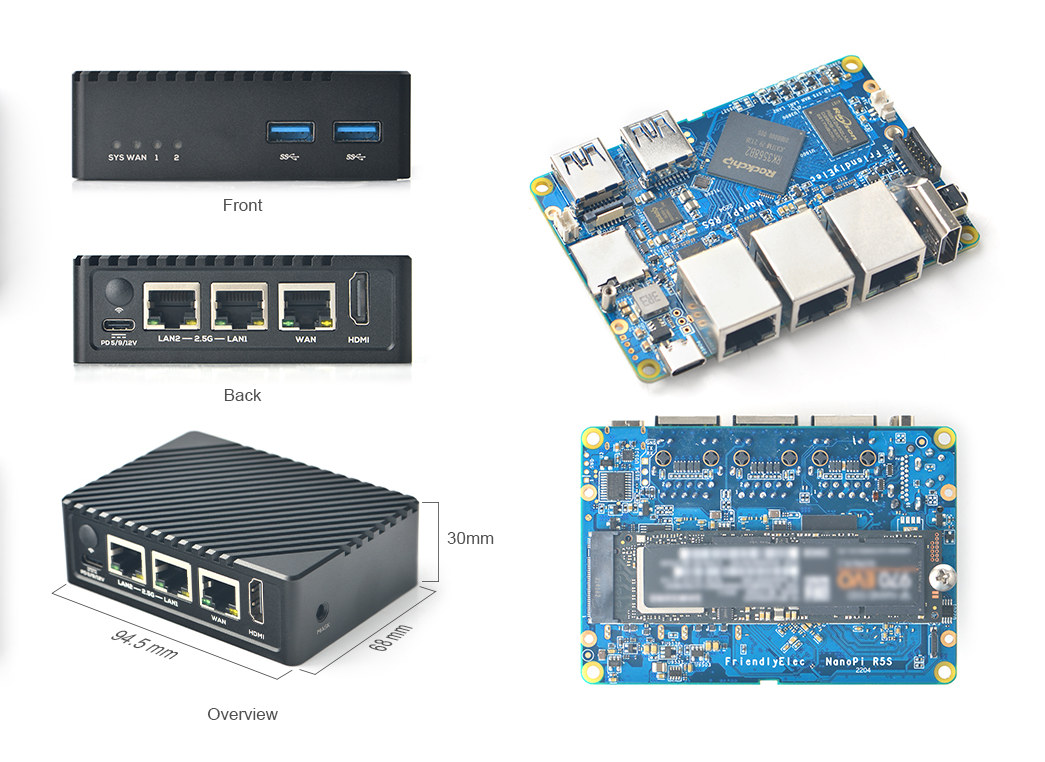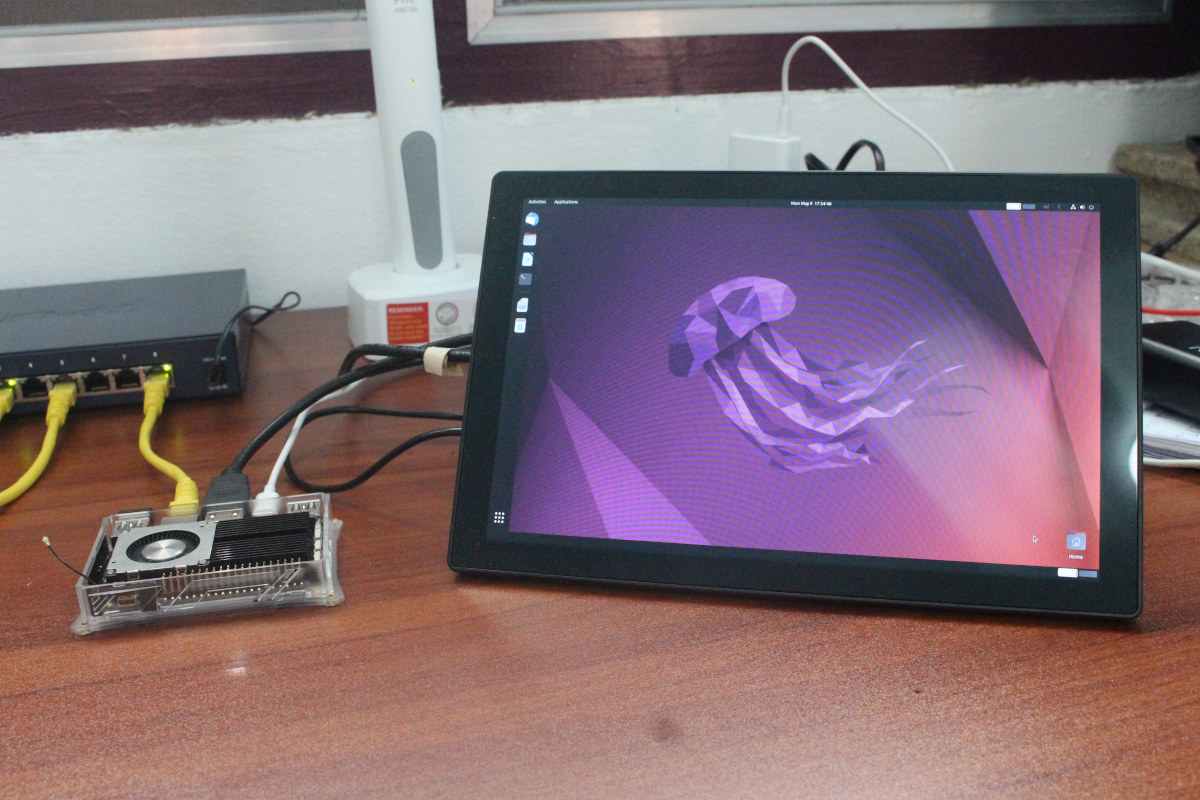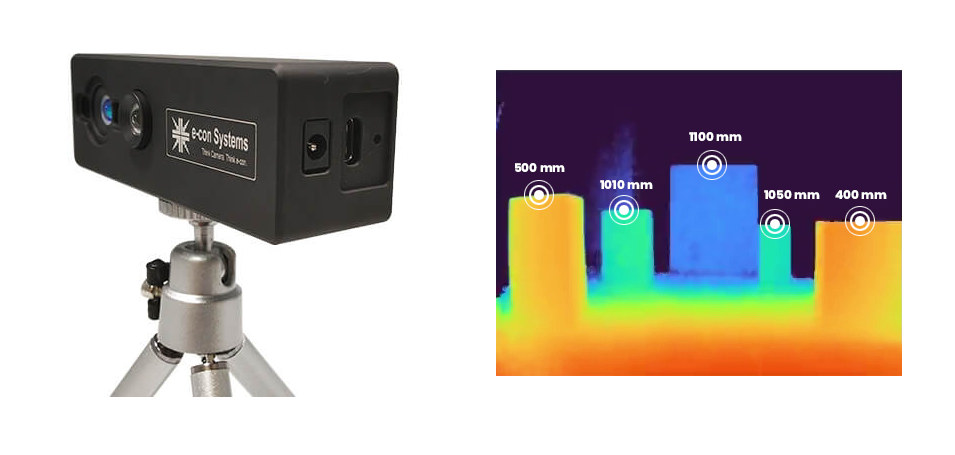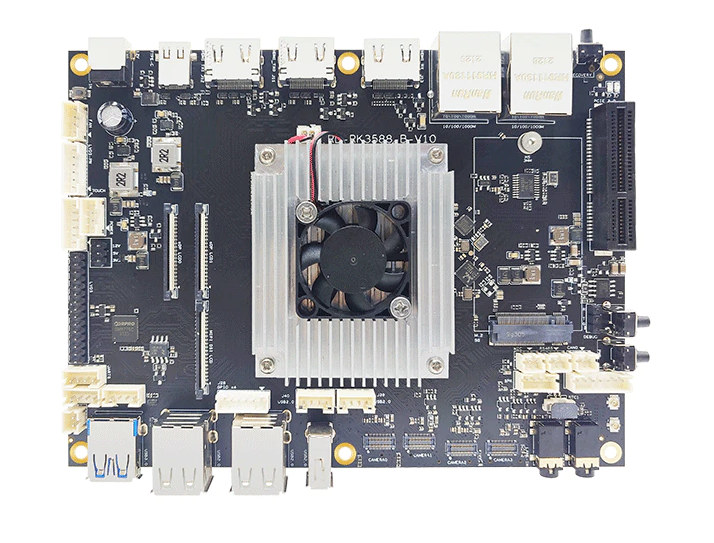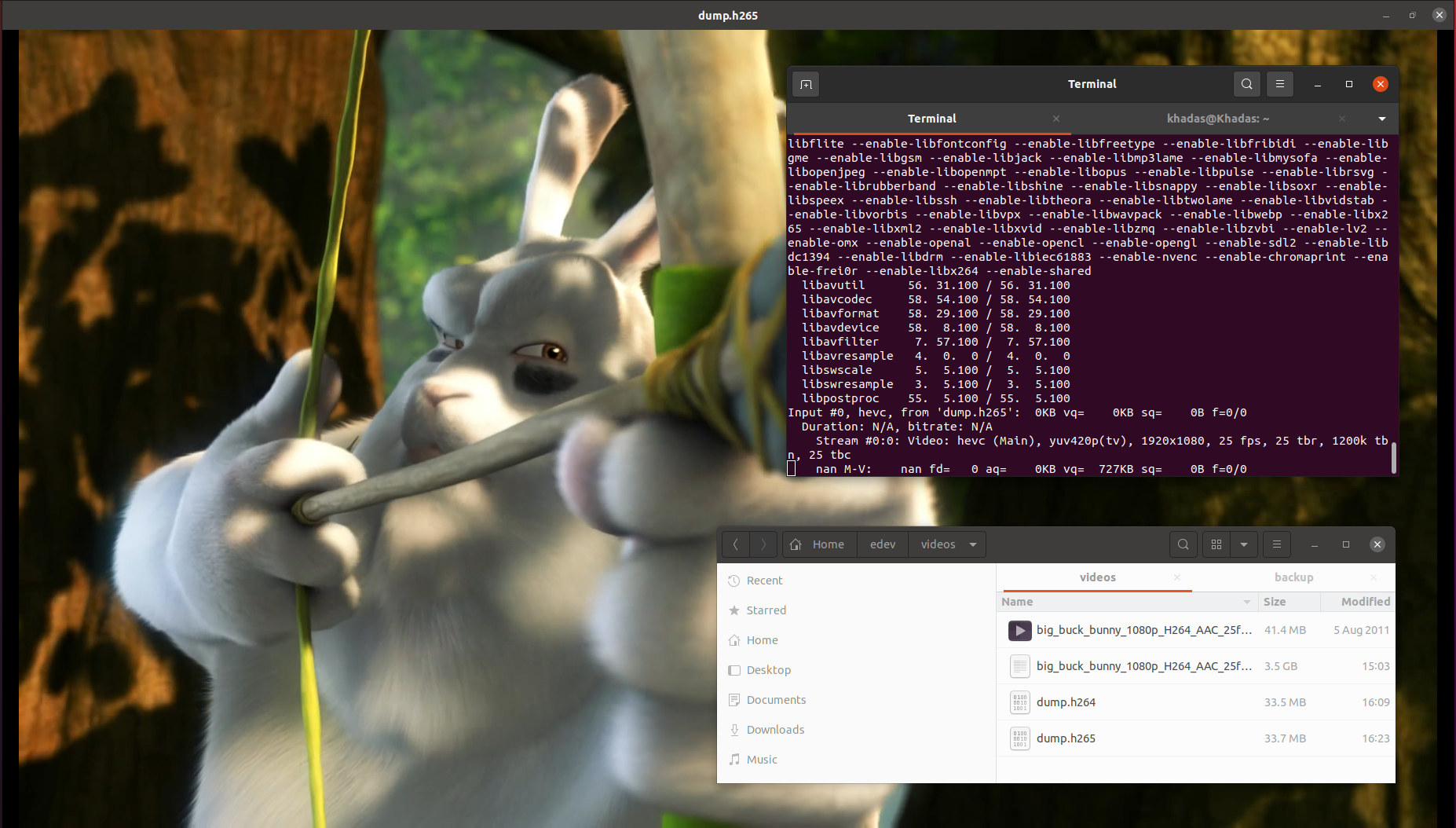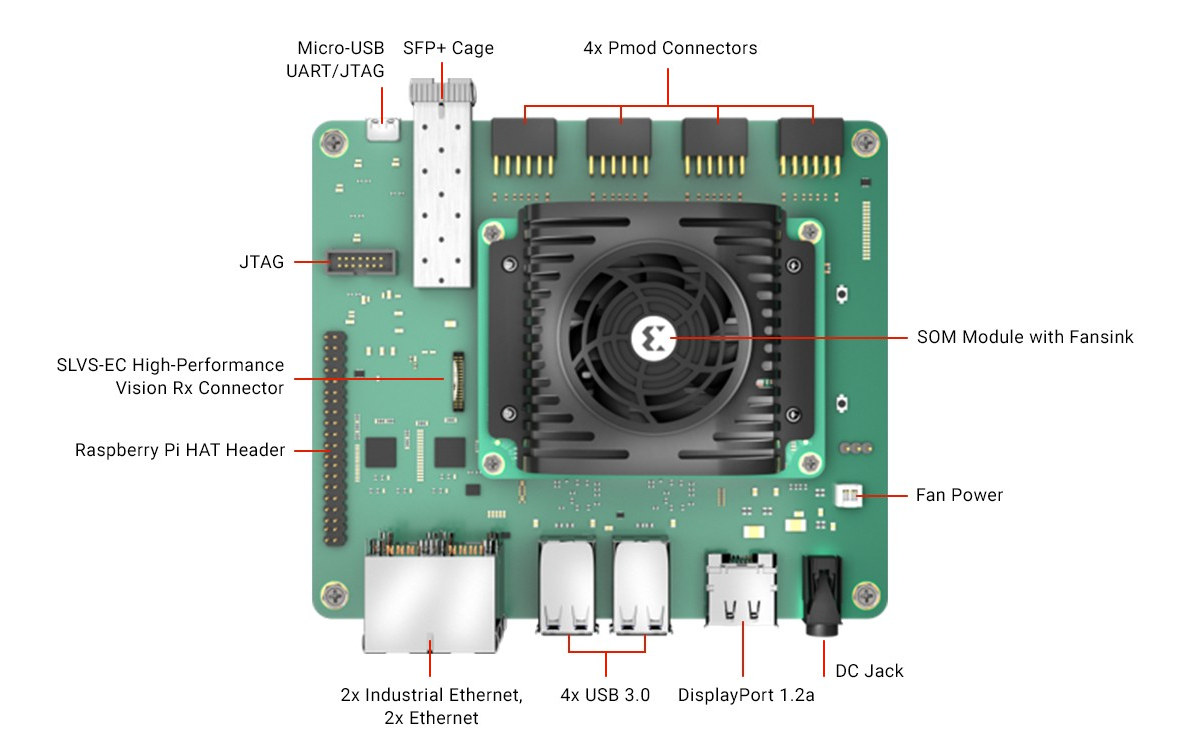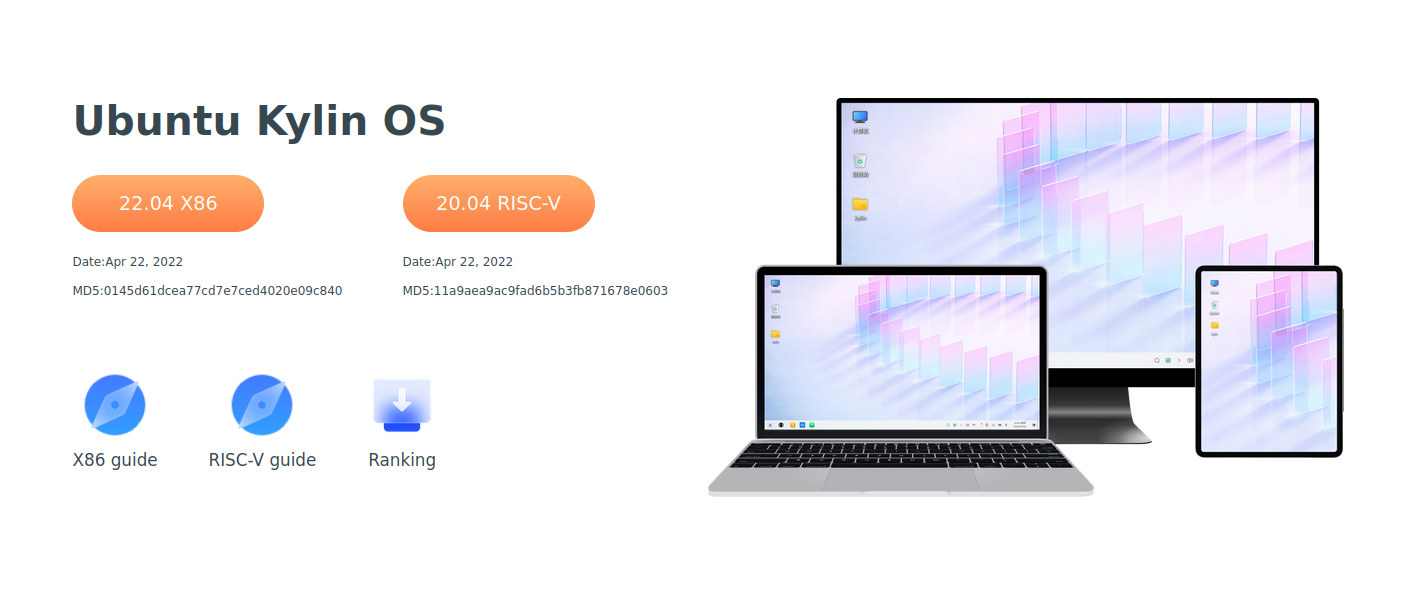The Rockchip RK3568-powered NanoPi R5S SBC with two 2.5GbE ports, one Gigabit Ethernet port, and M.2 NVMe storage is now available for $59, or $75 with a metal enclosure. As previously mentioned, the mini router board is equipped with 2GB RAM, 8GB eMMC flash, two USB 3.0 ports, as well as an HDMI output for people wanting to make use of the Rockchip RK3568 processor’s multimedia capabilities, or simply have a user interface on a monitor. NanoPi R5S specifications: SoC – Rockchip RK3568 quad-core Cortex-A55 processor @ up to 2.0 GHz with Arm Mali-G52 MP2 GPU, 0.8 TOPS AI accelerator, 4Kp60 H.265/H.264/VP9 video decoder, 1080p60 H.264/H.265 video encoder System Memory – 2GB LPDDR4X Storage 8GB eMMC flash for OS Key M socket for M.2 2280 (PCIe 2.0 x1) NVMe SSD support Optional SPI flash for network boot MicroSD card socket Video Output – 1x HDMI 2.0 port up to 4Kp60, […]
Khadas VIM4 SBC review – Part 3: Ubuntu 22.04
Here’s the last part of Khadas VIM4 review with Ubuntu 22.04 “Jammy Jellyfish”. You may want to check out our previous parts with the unboxing and first boot, followed by Android 11 if you haven’t already done so. Ubuntu 22.04 installation on Khadas VIM4 I used the same method of installation with OOWOW firmware that can download the image directly from Khadas server, and install it to the eMMC flash. Since I already had Android 11 running on the board, I had to keep pressing the function key (middle), then shortly press the reset button, before releasing the function key and entering OOWOW interface. From there, I selected Ubuntu 22.04 Gnome, and went ahead with the download. The download was fast with the 758.2MB compressed image downloaded in a couple of minutes, then I simply selected “Install” to go further, and replace Android 11… .. and after rebooting the board […]
DepthVista USB 3D ToF camera supports close range depth measurement, far-range object detection
DepthVista is a USB Time-of-Flight (ToF) camera designed for precise 3D depth measurement in close range mode (1.2m) and person and/or object detection in far-range mode up to 6 meters away. This ToF camera combines a 3D depth camera capable of 640 x 480 @ 30fps, and an Onsemi AR0234 color global shutter sensor supporting HD and FHD at up to 30fps, plus an 850nm VCSEL (vertical-cavity surface-emitting laser) for safety and the ability to operate in complete darkness. e-con Systems’ DepthVista (See3CAM_TOF_25CUG) specifications: Depth camera 3D camera technology: Time-of-Flight Depth range Near mode – 0.2m to 1.2m Far mode – 1m to 6m Illumination: 850nm pulsed laser (Indoor) Accuracy: Up to 1% depending on environmental conditions Output format: Y16 (raw 12-bit) Resolutions Depth – 640 x 480 @ 30fps IR – 640 x 480 @ 30fps Depth + IR – 640 x 960 @ 30fps FOV – 84.29° (H) […]
Rockchip RK3588 CPU module exposes more I/Os through four board-to-board connectors
We’ve already seen several Rockchip RK3588 modules with Firefly Core-3588J, Turing RK1, and Banana Pi RK3588_CV1, all with an edge connector to insertion into the carrier board. Rongpin RD-RK3588 system-on-module is a little different with four board-to-board connectors that enable a slightly more compact design, and should expose more I/Os than say a 314-pin MXM edge connector. The module ships with up to 16GB of RAM, 128 GB of storage, a Rockchip RK806-1 PMIC, and the company also offers a development kit with RD-RK3588-B baseboard fitted with the module for evaluation and early software development. RD-RK3588 board-to-board module RD-RK3588-C core module specifications: SoC – Rockchip RK3588 octa-core processor with 4x Arm Cortex-A76 cores @ up to 2.4 GHz, 4x Arm Cortex-A55 cores, Arm Mali-G610 MP4 GPU with support for OpenGL ES3.2, OpenCL 2.2, Vulkan1.1, 6 TOPS NPU, 48MP ISP, 8Kp60 video decoding, 8Kp30 video encoding System Memory – 4GB, 8GB, […]
Linux hardware video encoding on Amlogic A311D2 processor
I’ve spent a bit more time with Ubuntu 22.04 on Khadas VIM4 Amogic A311D2 SBC, and while the performance is generally good features like 3D graphics acceleration and hardware video decoding are missing. But I was pleased to see a Linux hardware video encoding section in the Wiki, as it’s not something we often see supported early on. So I’ve given it a try… First, we need to make a video in NV12 pixel format that’s commonly outputted from cameras. I downloaded a 45-second 1080p H.264 sample video from Linaro, and converted it with ffmpeg:
|
1 |
ffmpeg -i big_buck_bunny_1080p_H264_AAC_25fps_7200K.MP4 -pix_fmt nv12 big_buck_bunny_1080p_H264_AAC_25fps_7200K-nv12.yuv |
I did this on my laptop. As a raw video, it’s pretty big with 3.3GB of storage used for a 45-second video:
|
1 2 3 4 |
ls -lh total 3.3G -rw-rw-r-- 1 jaufranc jaufranc 40M Aug 5 2011 big_buck_bunny_1080p_H264_AAC_25fps_7200K.MP4 -rw-rw-r-- 1 jaufranc jaufranc 3.3G May 21 15:03 big_buck_bunny_1080p_H264_AAC_25fps_7200K-nv12.yuv |
Now let’s try to encode the video to H.264 on Khadas VIM4 board using aml_enc_test hardware video encoding sample:
|
1 2 3 4 5 6 7 8 9 10 11 12 13 14 15 16 17 18 19 20 21 22 23 24 25 26 27 28 29 30 |
khadas@Khadas:~$ time aml_enc_test 1080p.nv12 dump.h264 1920 1080 30 25 6000000 1125 1 0 2 4 src_url is : 1080p.nv12 ; out_url is : dump.h264 ; width is : 1920 ; height is : 1080 ; gop is : 30 ; frmrate is : 25 ; bitrate is : 6000000 ; frm_num is : 1125 ; fmt is : 1 ; buf_type is : 0 ; num_planes is : 2 ; codec is : 4 ; codec is H264 Set log level to 4 [initEncParams:177] enc_feature_opts is 0x0 , GopPresetis 0x0 [SetupEncoderOpenParam:513] GopPreset GOP format (2) period 30 LongTermRef 0 [vdi_sys_sync_inst_param:618] [VDI] fail to deliver sync instance param inst_idx=0 [AML_MultiEncInitialize:1378] VPU instance param sync with open param failed [SetSequenceInfo:979] Required buffer fb_num=3, src_num=1, actual src=3 1920x1080 Encode End!width:1920 real 0m26.074s user 0m1.832s sys 0m4.883s |
The output explains the parameters used. There are some error messages, […]
$349 AMD Kria KR260 Robotics Starter Kit takes on NVIDIA Jetson AGX Xavier devkit
AMD Xilinx Kria KR260 Robotics Starter Kit features the Kria K26 Zynq UltraScale+ XCK26 FPGA MPSoC system-on-module (SoM) introduced last year together with the Kria KV260 Vision AI Starter Kit. Designed as a development platform for robotics and industrial applications, the KR260 is said to deliver nearly 5x productivity gain, up to 8x better performance per watt and 3.5x lower latency compared to Nvidia Jetson AGX Xavier or Jetson Nano kits. We’ll have a better look at the details below. Kria KR260 Robotics Starter Kit specifications: SoM – Kria K26 module with: MPSoC – Xilinx Zynq Ultrascale+ custom-built XCK26 with quad-core Arm Cortex-A53 processor up to 1.5GHz, dual-core Arm Cortex-R5F real-time processor up to 600MHz, Mali-400 MP2 GPU up to 667MHz, 4Kp60 VPU, 26.6Mb On-Chip SRAM, 256K logic cells, 1,248 DSP slices, 144 Block RAM blocks, 64 UltraRAM blocks System Memory – 4GB 64-bit DDR4 (non-ECC) Storage – 512 Mbit […]
Ubuntu Kylin 20.04 OS works on RISC-V hardware
China-developed Ubuntu Kylin 20.04 is now supporting RISC-V architecture with an image for HiFive Unmatched mini-ITX motherboard, and work will be done on an unnamed Starfive SBC that should be the VisionFive board with a GPUless JH7100 dual-core RISC-V SoC or an upgraded version with JH7110 SoC featuring an Imagination IMG BXE-4-32 GPU. You may have read recent reports about China asking government entities, including state-owned enterprises (SOE), to replace foreign hardware and software within a two-year period. So that means avoiding systems based on Intel and AMD processors, so working on RISC-V open architecture makes perfect sense, since over time, Chinese manufacturers should be able to make RISC-V SoCs and PCs based on those processors, albeit probably not within the next two years at any significant scale. Ubuntu Kylin 20.04 RISC-V, as well as the newly released Ubuntu Kylin 22.04 x86, can be found on the English download page […]
Embedded World 2022 – June 21-23 – Virtual Schedule
Embedded World 2020 was a lonely affair with many companies canceling attendance due to COVID-19, and Embedded World 2021 took place online only. But Embedded World is back to Nuremberg, Germany in 2022 albeit with the event moved from the traditional month of February to June 21-23. Embedded systems companies and those that service them will showcase their latest solution at their respective booths, and there will be a conference with talks and classes during the three-day event. The programme is up, so I made my own little Embedded World 2022 virtual schedule as there may be a few things to learn, even though I won’t be attending. Tuesday, June 21, 2022 10:00 – 13:00 – Rust, a Safe Language for Low-level Programming Rust is a relatively new language in the area of systems and low-level programming. Its main goals are performance, correctness, safety, and productivity. While still ~70% of […]


